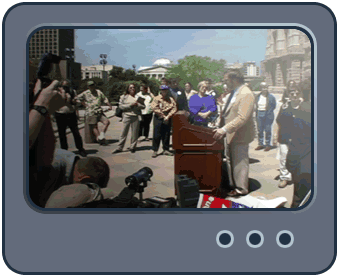 |
|
|
Not so long ago, political campaign insiders talked about "free media" – media coverage that appears as news rather than as advertising. Free media activities include everything from writing letters to the editor and opinion articles in newspapers, to responding to the now ubiquitous "fast polls" on TV and the Web, to getting the local stations or national network news to cover your campaign's events. Anything that would put your campaign or policy positions in the news, hopefully with the added benefit of displacing possible coverage of the competition, was considered free media. That seems to be a whole lot better than "paid media," which usually means expensive political advertisements. Since the first hurdle in political campaigning is just getting people's attention, campaigns want lots of the type of media that people tune into. News coverage tops the list, for several reasons. First, it's free if you can get it – or so it seems. Next, the public tends to pay more attention to news stories than to paid advertising. Finally, despite suspicions from all sides that the news media are biased, everyone knows for certain that all paid political advertising is slanted, and therefore easily discounted. News coverage may appear costless to campaigns. After all, if it's news, you do not have to write a check to a newspaper, television station, or commercial Web site to carry your story. If you plan to hold a campaign event anyway, then you might as well try to get the maximum coverage for your out-of-pocket expenses, right? Why not invite the press along to the events that you are already paying for? Eventually campaigners wised up to the fact that such media coverage was never free. They really had been earning their media coverage all along. It takes time and effort – and sometimes cash outlays – to "earn" media coverage. Even scheduled campaign events end up costing more in order to attract news coverage: bigger venues, better lighting, improved sound, larger crowds, and other media friendly arrangements all have costs attached. Activist organizations and political parties also emphasize the need to be timely, interesting, and compelling. You can work all day long, but you must be insightful enough to know what news outlets will regard as worthy of covering. This takes work. Furthermore, it helps to expend effort building relationships with reporters as part of the cost of earning their attention. The Kansas Democratic Party's checklist for local campaigns stresses the importance of having a compelling message and a good media plan: "Realistically, how much of your campaign will the press be interested in? ... There is a reason this is called earned media and not free media. You do not pay for the media to cover your campaign but you will have to earn it. You cannot expect the press to cover your campaign just because you are running for office. That is why you have to have a plan for how you will earn media coverage."[1] In recognition of all the time, effort and talent required, "free media" has been recast as "earned media." This self-conscious, new term seems aimed in equal parts at both campaign personnel and at those who control access to the mass public – television producers, news editors, reporters and writers. You want to make your team aware of the costs of all activities so that its members may function more efficiently. At the same time, you want to let the target of your efforts (the media) know that you really do deserve the coverage they provide. After all, you've earned it! |
|
| Footnote [1]: Kansas Democratic Party. (full footnote) | |